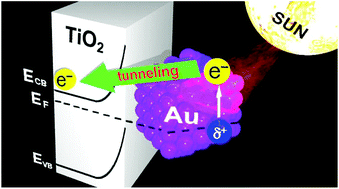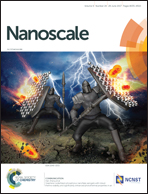Quantum tunneling injection of hot electrons in Au/TiO2 plasmonic photocatalysts†
Abstract
Visible light absorption of plasmonic Au nanoparticles supported on semiconductor TiO2 leads to injection of their photoactivated “hot electrons (ehot−)” into the TiO2 conduction band. This charge separation facilitates several oxidation and reduction reactions. These plasmonic systems, however, suffer from low quantum yields because the Schottky barrier created at the Au–TiO2 interface suppresses ehot− injection. Here we report that Au nanoparticles supported on the anatase particles isolated from Degussa (Evonik) P25 TiO2 promote ehot− injection with much higher efficiency than those supported on other commercially-available TiO2 and catalyze aerobic oxidation with very high quantum yield (7.7% at 550 nm). Photoelectrochemical and spectroscopic analysis revealed that the number of Ti4+ atoms located at the Au–TiO2 interface is the crucial factor. These Ti4+ atoms neutralize the negative charge of the Au particles and create a Schottky barrier with narrower depletion layer. This facilitates efficient ehot− injection by “quantum tunneling” through the Schottky barrier without overbarrier energy. The ehot− injection depends on several factors, and loading of 2 wt% Au particles with 3.5–4 nm diameters at around room temperature exhibits the highest activity of plasmonic photocatalysis.



 Please wait while we load your content...
Please wait while we load your content...